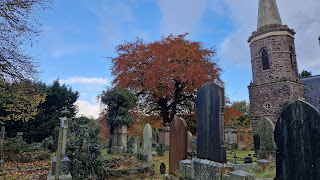'In the midst of life, thinking upon death': November, a month for churchyards
The meaning of the churchyard finds liturgical expression in a prayer approved by the Lower House of Convocation in 1712, from a form for the consecration of churches:
O God, Who hast taught us in Thy holy word that there is a difference between the spirit of a beast that goeth downwards to the earth, and the spirit of a man which ascendeth up to God who gave it; by the example of Thy holy servants, in all ages, hast taught us to assign peculiar places where the bodies of Thy saints may rest in peace, and be preserved from all indignities, whilst their souls are safely kept in the hands of their faithful Redeemer: accept, we beseech Thee, this charitable work of ours in separating this portion of ground to that good purpose, and give us grace, that, by the frequent instances of mortality we behold, we may learn and seriously consider how frail and uncertain our condition here on earth is, and so number our days as to apply our hearts unto wisdom; that in the midst of life thinking upon death, and daily preparing ourselves for the judgment that is to follow, we may have our part in the resurrection to life with Him, who died for our sins, and rose again for our justification, and now liveth and reigneth with Thee and the Holy Ghost, one God, world without end.
Although it did not receive the Royal Assent, this form was widely used in the centuries following. It can be found in the form for the consecration of a church and churchyards approved for use in the Diocese of Salisbury in 1855 and the Diocese of York in 1867. It can be found in use in PECUSA in 1848 and, lightly revised, in the Church of Ireland BCP 1878.
The prayer presents to us a threefold understanding of the churchyard. Firstly, it sets before us the good and godly example of setting aside a resting place for mortal remains:
by the example of Thy holy servants, in all ages, hast taught us to assign peculiar places where the bodies of Thy saints may rest in peace, and be preserved from all indignities, whilst their souls are safely kept in the hands of their faithful Redeemer.
We might think of Abraham burying Sarah at the Cave of Machpelah, which became the Tomb of the Patriarchs. Likewise, the "devout men" who carried the proto-martyr Stephen to his burial. The early Christian iconography of the catacombs also points to a sanctification of "peculiar places" in which mortal remains rested in the hope of the life everlasting.
Walking around a churchyard on a November day - particularly when the gravestones are marked by dates from past centuries - is to recall "the example of Thy holy servants" over the centuries, setting aside places of burial, a sign of death neither triumphant nor ignored, but gathered up and transfigured in faith, hope, and love.
Secondly, we might note how the prayer's phrase "whilst their souls are safely kept in the hands of their faithful Redeemer" is derived from Wisdom 3:1:
But the souls of the righteous are in the hand of God, and there shall no torment touch them.
This passage from Wisdom was the first lesson appointed to be read at Matins on All Saints' Day in the 1662 lectionary, ensuring that it had particular significance in relation to commemoration of the faithful departed. That James Nares set the text to music in his 1734 anthem is further evidence of the recognition of this text in Anglican piety and liturgy.
It is, therefore, a text to reflect upon as we slowly walk around a churchyard on a November day, for this is no grim resignation in the face of death. The churchyard - in its quietness, in its gentle rest for mortal remains, in the prayers offered over gravesides at burials - expresses the Christian hope: "the souls of the righteous are in the hand of God".
Thirdly, the prayer is a call to memento mori:
give us grace, that, by the frequent instances of mortality we behold, we may learn and seriously consider how frail and uncertain our condition here on earth is, and so number our days as to apply our hearts unto wisdom; that in the midst of life thinking upon death, and daily preparing ourselves for the judgment that is to follow ...
We hear, of course, the echo of words from the Order for the Burial of the Dead, both in the phrase from Psalm 90 and from the anthem recited at the graveside. The churchyard is a reminder to us of our mortality, a call to prayerfully reflect upon it and to pray - as we do in the Litany - for grace "in the hour of death, and in the day of judgement".
As the end of another year draws nigh, as we prepare for the season of Advent and its meditation on the last things, reflectively walking around a churchyard on a November day is a practice to be commended. Memento mori.
May this month of November, with the leaves falling and the days short, find us in a churchyard, recollecting how this godly practice of setting aside places for the rest of mortal remains has been followed by the people of God over centuries; thankful that the faithful love of our Creator and Redeemer holds the departed; and, remembering that our earthly pilgrimage will one day end, praying that "we may have our part in the resurrection to life with Him, who died for our sins, and rose again for our justification".
(The photograph is of the churchyard of Drumbeg Parish Church, close to Belfast, 3rd November 2023.)




Comments
Post a Comment